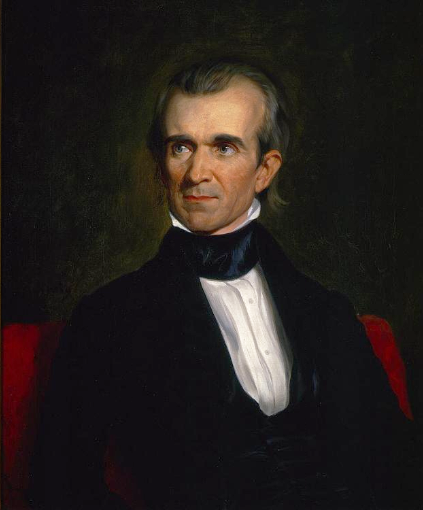On June 15, 1849, just a short 103 days after leaving the office of President, James K. Polk succumbed to what was likely cholera, breathing his last words to his wife, “I love you, Sarah, for all eternity, I love you." Over the course of the next several decades the remains of James K Polk would be moved twice and finally end up, along side his wife, at the Tennessee State Capitol.
 | |
| McKendree Methodist Church, location of James K Polks Funeral |
 | |
| Central Avenue at the Nashville City Cemetery |
 |
| Polk Place, circa 1880 |
 |
| The historic marker at the location where Polk Place once stood |
(see after the Governor bio for bonus pictures)
#12
Name: James Knox Polk
Birth: 2 November 1795
Death: 15 June 1849
Age at Death: 53 years, 7 months, 12 days old
Age at Death: 53 years, 7 months, 12 days old
Interment: Tennessee State Capitol
Term in Office: October 14, 1839 – October 15, 1841
Pollitical Party: Democrat
 | |
| James K and Sarah Polk's monument as it looks today |
Samuel and Jane Polk in Mecklenburg County,
North Carolina. The family would move to the Nashville area when he was still a child. Graduating from the University of North Carolina he would return to Nashville to practice law, apprenticing under Felix Grundy. He would go on to open his own law practice in Columbia, TN, where he would meet and work with another future Governor, Aaron V. Brown. In 1823, his political career began when he won a seat on the Tennessee State Legislature. He would marry his wife, Sarah Childress, the following year on January 1, 1824. The two would never have children, likely the result of a surgery that James had as a child to remove urinary tract stones, leaving him sterile. In 1825, he was elected to the United States Senate, where he would spend the next 14 years. Becoming the Speaker of the House in 1835, he worked tirelessly pushing the agenda of fellow Tennessean, President Andrew Jackson, earning himself the nickname 'Young Hickory'. At the bequest of Jackson, Polk left congress in 1839 and returned to Tennessee to run for Governor of the State. Defeating Newton Cameron, James would only serve one term and be defeated in the next two Gubernatorial races in 1841 and 1843 by James C. Jones. He would find himself thrust upon the national stage the following year when he became the first "dark horse" candidate for the Presidency. Running on an agenda consisting of four main points: the reestablishment of the national treasury, lowering of the tariffs, acquiring the Oregon Territory from Britain and acquiring Texas and California from Mexico. He also promised that if elected he would serve only one term. Defeating the Whig, Henry Clay, James was seated as President on March 4, 1845. At the end of his term, he had accomplished all of his goals, making the United States a truly Continental Nation, stretching from the Atlantic to Pacific Oceans. Honoring his promise of serving only one term he did not seek his parties nomination. The four years in office and the stress left James in frail health and he likely contracted cholera in New Orleans, while on a good will tour of the South following his Presidency. Returning to his home in Nashville, James K Polk died on June 15 1845. His retirement, at only 103 days, is still the shortest of any President. His widow, Sarah Childress Polk, would live the next 42 years in widowhood, the longest of any other first lady and die on August 14, 1891.
~BONUS PICTURES~
 |
| Major Knox pays his respects to James Knox |
 |
| Another marker for Polk Place--this one is obscured by a security gate. |
 |
| William Strickland, designer of the Tennessee State Capitol and James K Polk's monument, is interred in the wall of the State Capitol |





No comments:
Post a Comment